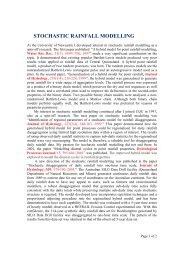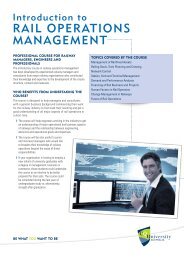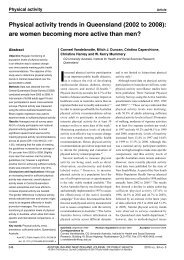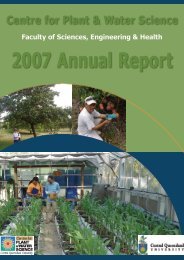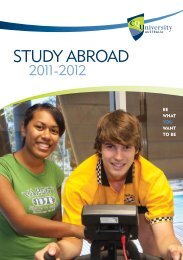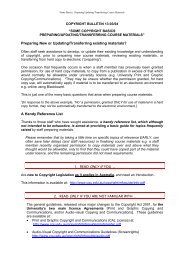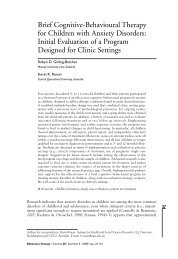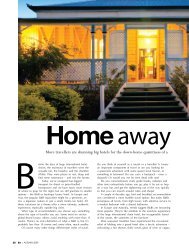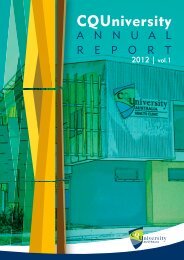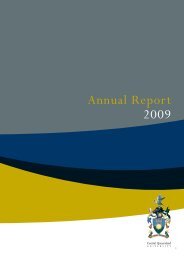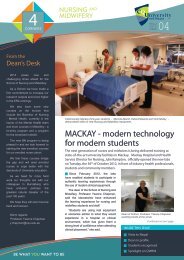4 Corners Newsletter - Vol 2 - Central Queensland University
4 Corners Newsletter - Vol 2 - Central Queensland University
4 Corners Newsletter - Vol 2 - Central Queensland University
Create successful ePaper yourself
Turn your PDF publications into a flip-book with our unique Google optimized e-Paper software.
TEACHING WITH TECHNOLOGY<br />
Melissa Hulme, Laboratory Supervisor/Instructor (Health) at CQUni, believes<br />
that teaching with technology opens the door to many new teaching<br />
approaches for nurse educators, but it is a learned skill that involves<br />
considerable knowledge and ability.<br />
“The compelling need for technological<br />
fluency and competency among nurse<br />
educators has increased with the introduction<br />
of simulation models such as SimMan 3G and<br />
hi-tech computer teaching aids,” says Melissa.<br />
“While these technological innovations allow<br />
for more choices, enhanced faculty-student<br />
interaction, and variations in learning, the<br />
nurse educators still need to incorporate the<br />
technology into their repertoire of teaching<br />
strategies.”<br />
Melissa heads a multi-expertise technical<br />
support team of five that provides highquality<br />
and effective technical support to<br />
nurse educators across four campuses<br />
– Rockhampton, Mackay, Bundaberg and<br />
Noosa.<br />
“The team provides resources that<br />
simulate real life experiences, from the<br />
paperwork they might expect to use in a clinic<br />
to wound exudate that is “real’ looking,” says<br />
Melissa. “We provide pathology trays that<br />
mirror exactly the equipment that would be<br />
used for venipuncture; chest drains that are<br />
used currently in industry; and a resuscitation<br />
trolley that reflects current industry standard.”<br />
These are just a couple of examples of what<br />
we provide.<br />
Each technician identifies the academics’<br />
diverse needs and oversees the progress of<br />
all programs at their campus. The technical<br />
staff are provided the Laboratory requirements<br />
by the Course Coordinator and then discuss<br />
the needs of the academic in relation to that<br />
list for each campus. Prior to each teaching<br />
program the technician is on hand to assist in<br />
the set up of the labs and where necessary<br />
to demonstrate the use and features of<br />
the technology, and during the class the<br />
technician is available to operate mannequins<br />
and address any technical issues that arise.<br />
“The team understand the potential<br />
of current learning technologies and are<br />
adept at liaising with academics, students<br />
and stakeholders across disciplines at the<br />
university,” says Melissa. “For example,<br />
with the recent course accreditation, we<br />
are required to have one Nursing Annie<br />
mannequin for every second bed across<br />
four campuses and infusion pumps for every<br />
second bed at each campus, which involves<br />
a lot of functionality and capability training.<br />
Plus, there is the ongoing training of the new<br />
SimMan 3G at Noosa campus to ensure that<br />
it is utilised to its full potential.<br />
Melissa says communication is important<br />
and her team ensures all academics receive<br />
‘multi-point support’ and encourage the<br />
academics to discuss their needs to the<br />
technical staff to ensure a quality educational<br />
environment including technical training<br />
workshops, one on one meetings, and face<br />
to face support to ensure that the labs are set<br />
up to accommodate student numbers.<br />
“It’s important that we utilise the time of<br />
academics and technical staff effectively,<br />
and it is critical to the ongoing improvement<br />
of the program that we have the opportunity<br />
to discuss concerns and develop good<br />
practice with technologies in teaching.<br />
In addition, the team relies on anecdotal<br />
evidence from student’s perception and<br />
experience of the technology and the effects<br />
on student learning. Ongoing modifications<br />
and enhancements are made so the final<br />
deliverable is aligned with best educational<br />
practice and reflect industry changes.<br />
The team itself relies on video links for<br />
meetings and catch-ups, and retains close<br />
network ties to the industry and foster<br />
relationships with local clinical educators to<br />
remain abreast of industry standards. “The<br />
best part of the job is the ongoing contact we<br />
have with the students,” says Melissa. “You<br />
see the growth from first to third year students,<br />
and it is wonderful to be a part of that.”<br />
Strengthening<br />
regional<br />
relationships<br />
In July, Professor Ysanne<br />
Chapman and Assoc Professor<br />
Melanie Birks attended the<br />
2012 Nursing and Allied Health<br />
Conference in Malaysia themed<br />
‘Evidence and Practice: the<br />
twain shall meet’ to converse on<br />
evidence based practice (EBP)<br />
across all medical fields.<br />
“The Malaysian hosts<br />
were welcoming, friendly<br />
and talked of developing a<br />
continuing relationship with the<br />
School,” said Ysanne. “It was<br />
a dynamic conference, where<br />
new professional friendships<br />
were forged with nursing<br />
and allied health colleagues,<br />
possible projects discussed with<br />
researchers in Malaysia, as well<br />
as potential higher degrees by<br />
research students.<br />
“For the vivacious and everpopular<br />
Melanie, it was an<br />
opportunity to reconnect with past<br />
colleagues and students.”<br />
Melanie Birks learnt how to throw a<br />
poison dart from a Borneo tribesman.<br />
7





